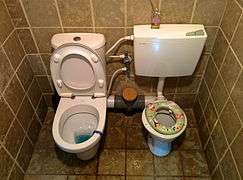Toilet training

Toilet training, or potty training, is the process of training a young child to use the toilet for urination and defecation, though training may start with a smaller toilet bowl-shaped device (often known as a potty). Cultural factors play a large part in what age is deemed appropriate, with the expectation for being potty trained ranging from 12 months for some tribes in Africa[1] to 36 months in the modern United States.[2] Most children can control their bowel before their bladder, boys typically start and finish later than girls, and it usually takes boys longer to learn to stay dry throughout the night, however it depends on the maturity and consistency of the particular child.[3]
Modern practice
Most people advise that toilet training is a mutual task, requiring cooperation, agreement and understanding between the child and the caregiver, and the best potty training techniques emphasize consistency and positive reinforcement over punishment – making it enjoyable for the child. The vast majority of studies concentrate on children 18 months old and older. In this age range, research suggests that children over 24 months train faster and girls train slightly faster than boys.[4][5][6]
History in the United States
Until the mid-1900s, the vast majority of babies finished toilet training by 2 years, and achieved nighttime dryness by 3 years.[7] Since then, the age for toilet training has increased dramatically. The convenience of disposable diapers, pull-up diapers (such as Huggies Pull-Ups introduced in 1989) and more efficient laundry facilities may contribute to this trend.
In 1957, the average age of starting toilet training was still under the age of one year, 11 months, and 90% of children were dry during the day by 2 years.[7]
In 2002, the average age that parents recognized their child "showing an interest in using the potty" was 24–25 months, and daytime dryness was achieved on average at almost 3 years of age.[3] Now nighttime accidents are considered normal until 5 or 6 years of age.[8]
Gallery
 Duo toilet for child training in a banquet hall
Duo toilet for child training in a banquet hall_(3018505985).jpg) Stacked dual-sized toilet seats for child training
Stacked dual-sized toilet seats for child training
See also
- Bedwetting
- Elimination communication
- Housebreaking
- Urinal
- Infant potty training method
- Baby-led potty training
References
- ↑ Devries, MW; Devries, MR (1977). "Cultural relativity of toilet training readiness: A perspective from East Africa". Pediatrics. 60 (2): 170–7. PMID 887331.
- ↑ Blum NJ, Taubman B, Nemeth N (2003). "Relationship between age at initiation of toilet training and duration of training: A prospective study". Pediatrics. 111 (4 Pt 1): 810–4. doi:10.1542/peds.111.4.810. PMID 12671117.
- 1 2 Schum, T. R.; Kolb, T. M.; McAuliffe, T. L.; Simms, M. D.; Underhill, R. L.; Lewis, M. (2002). "Sequential acquisition of toilet training skills: A descriptive study of gender and age differences in normal children". Pediatrics. 109 (3): e48. doi:10.1542/peds.109.3.e48. PMID 11875176.
- ↑ Toilet Training Your Child. FamilyDoctor.org. Retrieved on 2012-01-23.
- ↑ Surviving Toilet Training. Childwelfare.gov. Retrieved on 2012-01-23.
- ↑ Health: Toddlers and toilet training. BBC. Retrieved on 2012-01-23.
- 1 2 Sears, Robert R., Maccoby, Eleanor and Levin, Harry (1957). Patterns of Child Rearing. pp. 102–137. Evanston IL: Row, Peterson, and Co.
- ↑ Toilet Training. aap.org